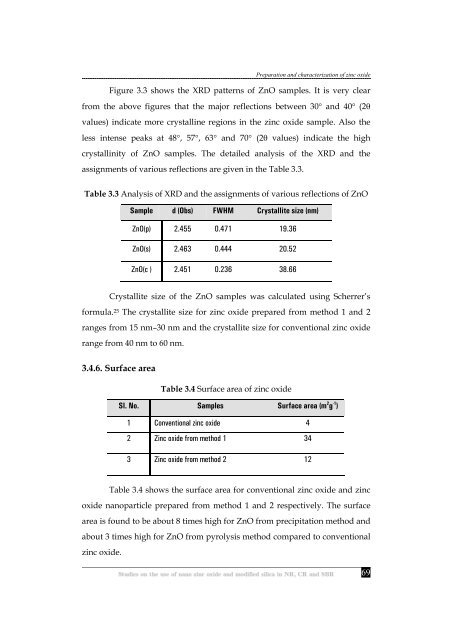Studies on the use of nano zinc oxide and modified silica in NR, CR ...
Studies on the use of nano zinc oxide and modified silica in NR, CR ...
Studies on the use of nano zinc oxide and modified silica in NR, CR ...
You also want an ePaper? Increase the reach of your titles
YUMPU automatically turns print PDFs into web optimized ePapers that Google loves.
Preparati<strong>on</strong> <strong>and</strong> characterizati<strong>on</strong> <strong>of</strong> <strong>z<strong>in</strong>c</strong> <strong>oxide</strong><br />
Figure 3.3 shows <strong>the</strong> XRD patterns <strong>of</strong> ZnO samples. It is very clear<br />
from <strong>the</strong> above figures that <strong>the</strong> major reflecti<strong>on</strong>s between 30° <strong>and</strong> 40° (2θ<br />
values) <strong>in</strong>dicate more crystall<strong>in</strong>e regi<strong>on</strong>s <strong>in</strong> <strong>the</strong> <strong>z<strong>in</strong>c</strong> <strong>oxide</strong> sample. Also <strong>the</strong><br />
less <strong>in</strong>tense peaks at 48°, 57°, 63° <strong>and</strong> 70° (2θ values) <strong>in</strong>dicate <strong>the</strong> high<br />
crystall<strong>in</strong>ity <strong>of</strong> ZnO samples. The detailed analysis <strong>of</strong> <strong>the</strong> XRD <strong>and</strong> <strong>the</strong><br />
assignments <strong>of</strong> various reflecti<strong>on</strong>s are given <strong>in</strong> <strong>the</strong> Table 3.3.<br />
Table 3.3 Analysis <strong>of</strong> XRD <strong>and</strong> <strong>the</strong> assignments <strong>of</strong> various reflecti<strong>on</strong>s <strong>of</strong> ZnO<br />
Sample d (Obs) FWHM Crystallite size (nm)<br />
ZnO(p) 2.455 0.471 19.36<br />
ZnO(s) 2.463 0.444 20.52<br />
ZnO(c ) 2.451 0.236 38.66<br />
Crystallite size <strong>of</strong> <strong>the</strong> ZnO samples was calculated us<strong>in</strong>g Scherrer’s<br />
formula. 25 The crystallite size for <strong>z<strong>in</strong>c</strong> <strong>oxide</strong> prepared from method 1 <strong>and</strong> 2<br />
ranges from 15 nm–30 nm <strong>and</strong> <strong>the</strong> crystallite size for c<strong>on</strong>venti<strong>on</strong>al <strong>z<strong>in</strong>c</strong> <strong>oxide</strong><br />
range from 40 nm to 60 nm.<br />
3.4.6. Surface area<br />
Table 3.4 Surface area <strong>of</strong> <strong>z<strong>in</strong>c</strong> <strong>oxide</strong><br />
Sl. No. Samples Surface area (m 2 g -1 )<br />
1 C<strong>on</strong>venti<strong>on</strong>al <strong>z<strong>in</strong>c</strong> <strong>oxide</strong> 4<br />
2 Z<strong>in</strong>c <strong>oxide</strong> from method 1 34<br />
3 Z<strong>in</strong>c <strong>oxide</strong> from method 2 12<br />
Table 3.4 shows <strong>the</strong> surface area for c<strong>on</strong>venti<strong>on</strong>al <strong>z<strong>in</strong>c</strong> <strong>oxide</strong> <strong>and</strong> <strong>z<strong>in</strong>c</strong><br />
<strong>oxide</strong> <strong>nano</strong>particle prepared from method 1 <strong>and</strong> 2 respectively. The surface<br />
area is found to be about 8 times high for ZnO from precipitati<strong>on</strong> method <strong>and</strong><br />
about 3 times high for ZnO from pyrolysis method compared to c<strong>on</strong>venti<strong>on</strong>al<br />
<strong>z<strong>in</strong>c</strong> <strong>oxide</strong>.<br />
69

















